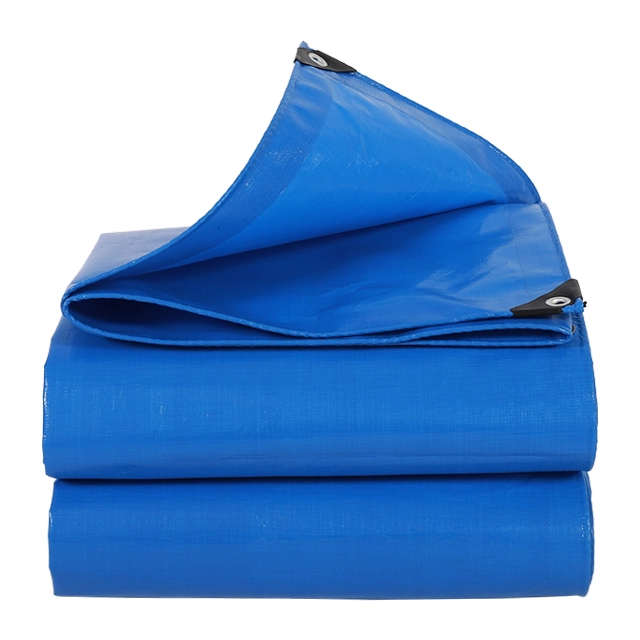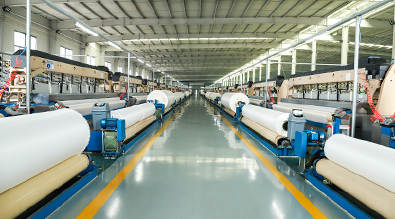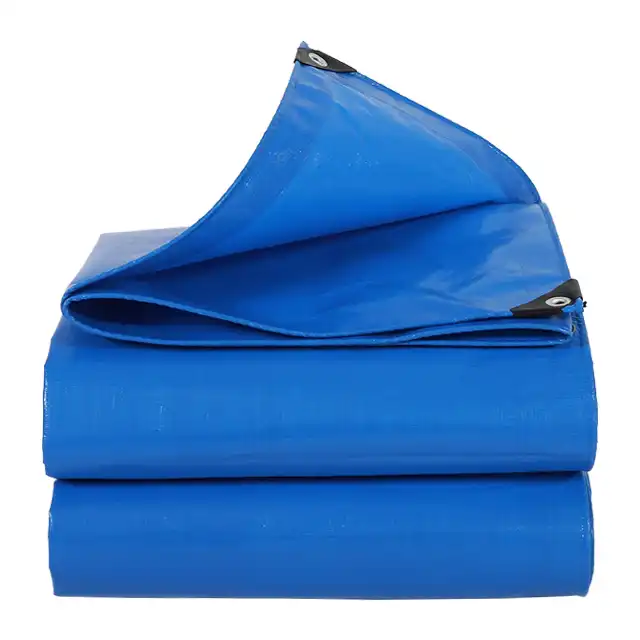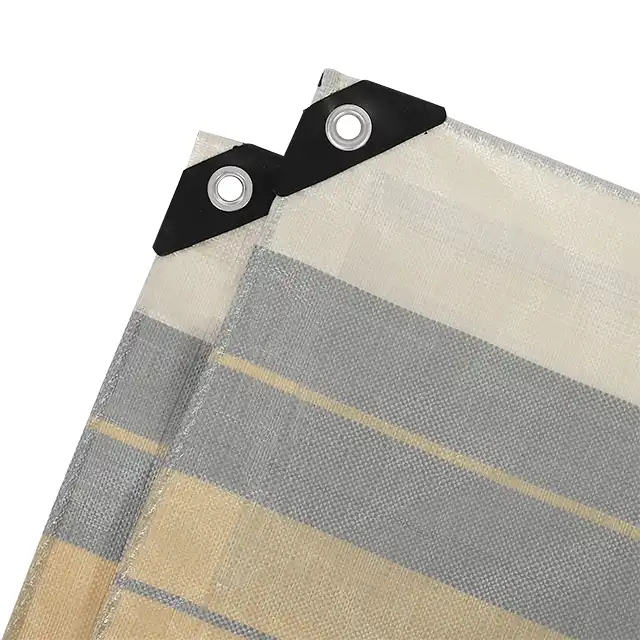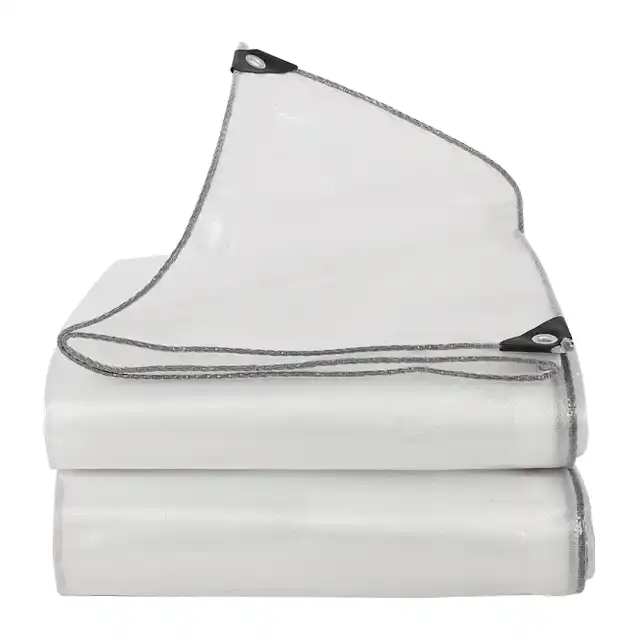How to Remove Stubborn Stains from Your Tarp: A Complete Guide
Tarps are indispensable tools for various applications, from protecting outdoor equipment to covering construction sites. However, these durable tarpaulin sheets often encounter stubborn stains during their service life that can compromise their appearance and potentially their functionality. Whether you're dealing with mold, rust, tree sap, or oil marks on your tarpaulin, this comprehensive guide will walk you through effective methods to restore your tarp to its former glory. With proper cleaning techniques and the right products, even the most challenging stains can be eliminated from high-quality PE tarpaulins, helping extend their usable lifespan and maintain their protective capabilities.
Understanding Different Types of Tarp Stains
Common Biological Stains and Their Characteristics
 Biological stains represent one of the most frequent challenges tarpaulin owners face. These include mold, mildew, algae, and organic matter like bird droppings or tree sap. When tarpaulins are exposed to humid conditions without proper drying, microscopic spores can settle and flourish on the surface, creating unsightly black, green, or white patches. High-quality tarpaulins like those manufactured by Linyi Shengde Plastic Co., Ltd. utilize advanced HDPE woven fabric with LDPE coating to resist moisture penetration, but even these premium tarps can develop biological growth if stored wet for extended periods. The polyethylene construction of modern tarps (ranging from 65gsm to 280gsm depending on the application) provides some inherent resistance, but no tarp is completely immune to these issues. Particularly for applications like greenhouse fabrics, aquaculture covers, or outdoor storage, where tarps remain in damp environments, addressing these biological stains promptly is essential to maintain the tarp's 100% waterproof capability and extend its service life. Understanding that these stains typically result from organic growth rather than simple surface dirt helps in selecting the appropriate cleaning approach that will eliminate the living organisms without damaging the tarp's protective coating or compromising its tear-resistant properties.
Biological stains represent one of the most frequent challenges tarpaulin owners face. These include mold, mildew, algae, and organic matter like bird droppings or tree sap. When tarpaulins are exposed to humid conditions without proper drying, microscopic spores can settle and flourish on the surface, creating unsightly black, green, or white patches. High-quality tarpaulins like those manufactured by Linyi Shengde Plastic Co., Ltd. utilize advanced HDPE woven fabric with LDPE coating to resist moisture penetration, but even these premium tarps can develop biological growth if stored wet for extended periods. The polyethylene construction of modern tarps (ranging from 65gsm to 280gsm depending on the application) provides some inherent resistance, but no tarp is completely immune to these issues. Particularly for applications like greenhouse fabrics, aquaculture covers, or outdoor storage, where tarps remain in damp environments, addressing these biological stains promptly is essential to maintain the tarp's 100% waterproof capability and extend its service life. Understanding that these stains typically result from organic growth rather than simple surface dirt helps in selecting the appropriate cleaning approach that will eliminate the living organisms without damaging the tarp's protective coating or compromising its tear-resistant properties.
Industrial and Chemical Stains That Challenge Tarpaulin Material
Industrial environments present unique challenges for tarpaulin maintenance due to exposure to chemicals, oils, grease, and industrial residues. When tarps are used as truck covers, goods protection, or in manufacturing settings, they frequently encounter these aggressive substances that can penetrate the tarp's surface. The middle-duty PE tarpaulins with weights ranging from 100gsm to 180gsm are commonly used in these settings and feature mesh counts between 10x10 and 14x14, providing substantial resistance to many substances. However, petroleum-based products like motor oil, diesel, or industrial lubricants can create particularly stubborn stains that bond with the polyethylene material. Chemical spills involving solvents, acids, or bases may not only stain but potentially compromise the integrity of the tarp if not addressed properly. The UV treatment (typically 1%-7%) that manufacturers like Sendow Tarpaulin incorporate helps prevent degradation from sunlight but doesn't necessarily protect against chemical damage. These industrial stains often require specialized cleaning approaches because conventional soap may prove ineffective against hydrocarbon-based residues. Understanding the chemical interaction between specific industrial contaminants and the tarpaulin's polyethylene construction is crucial for selecting appropriate cleaning agents that will remove the stain without degrading the tarp's anti-corrosion properties or affecting its arctic flexibility that allows it to remain pliable even in extremely cold conditions.
Environmental Stains from Weather and Natural Elements
Environmental factors continuously challenge tarpaulin materials through exposure to diverse weather conditions and natural elements. Premium PE tarpaulins, despite their waterproof and tear-resistant qualities, inevitably encounter environmental staining from factors like rust transfer, mineral deposits from hard water, tree sap, pollen, and soil. When tarpaulins are used for applications such as wood covers, sun shade structures, or greenhouse fabrics, they face constant exposure to environmental contaminants. The laminated construction of quality tarps (with thicknesses between 7-12 mil) provides significant protection, but prolonged contact with rusty surfaces can transfer iron oxide stains that penetrate deeply into the material. Similarly, areas with mineral-rich rainwater may leave calcium or lime deposits that appear as white, chalky residues on the tarp surface. The HDPE woven fabric base of professional-grade tarpaulins offers excellent resistance to environmental damage, but cannot completely prevent visual discoloration. Seasonal challenges like fallen leaves in autumn can release tannins that stain light-colored tarps, while bird droppings contain uric acid that can etch into the tarp's surface if left untreated. Understanding these environmental interactions helps tarp owners develop maintenance schedules that address regional challenges specific to their climate. Customers using Sendow Tarpaulin products benefit from materials specifically engineered to withstand these environmental challenges through their specially formulated coatings and UV treatments, but regular cleaning remains essential to preserve both functionality and appearance of these highly durable polyethylene protective covers.
Effective Cleaning Solutions for Different Stain Types
Safe Chemical Solutions for Biological Stain Removal
When tackling biological stains on tarpaulin materials, selecting the right cleaning agents ensures effective removal without compromising the tarp's integrity. For mold and mildew stains that commonly develop when tarps are used for leisure tents, picnic pads, or greenhouse applications, a solution of one part white vinegar to four parts water proves remarkably effective. This mild acidic mixture kills the fungal growth while being gentle enough for the tarp's UV-treated surface. For more stubborn biological growth, a diluted bleach solution (one part bleach to ten parts water) can be applied, but should be thoroughly rinsed afterward to prevent degradation of the polyethylene material. Many users of high-quality Sendow Tarpaulins, which feature waterproof and shrink-proof properties, find that hydrogen peroxide solutions (3%) provide excellent cleaning power for organic matter without the harshness of bleach. When dealing with tree sap or bird droppings on tarps used for wood covers or sun shade applications, isopropyl alcohol (70%) applied with a soft cloth can break down these sticky residues without affecting the tarp's anti-freezing capabilities. It's important to note that professional-grade PE tarpaulins with weights ranging from 65gsm to 280gsm can withstand these cleaning solutions when properly diluted and applied. After applying any chemical cleaner, thorough rinsing is essential to preserve the tarp's special coating that provides its waterproof and tear-resistant qualities. For particularly delicate applications like aquaculture impermeable tarps, enzyme-based cleaners formulated for outdoor fabrics offer a biodegradable alternative that effectively breaks down protein-based stains while being environmentally friendly and safe for aquatic environments.
Industrial-Strength Approaches for Oil and Grease Removal
Removing industrial contaminants from tarpaulin materials demands specialized techniques that target hydrocarbon-based substances without damaging the tarp's protective coating. For tarps used in industrial settings, truck covers, or goods protection where exposure to grease and oils is common, dish soap solutions enhanced with degreasing agents provide an effective first treatment. The middle-duty PE tarpaulins manufactured by Linyi Shengde Plastic Co., Ltd., with their robust 7-12 mil thickness and specialized LDPE coating, can withstand targeted cleaning with citrus-based degreasers that break down petroleum residues through natural solvents. For particularly stubborn oil stains on high-quality tarps with mesh counts between 10x10 and 14x14, applying an absorbent material like cornstarch or baking soda as a preliminary step helps draw out excess oil before wet cleaning begins. Allow the powder to sit for 24 hours to absorb as much of the contaminant as possible. For automotive fluids on tarps used as car canopies, a specialized automotive degreaser diluted to half-strength helps preserve the tarp's UV treatment (1%-7%) while effectively removing the stain. The HDPE woven fabric construction of premium tarpaulins allows them to withstand these cleaning processes without losing their highly durable and anti-corrosion characteristics. For industrial adhesive residues that sometimes transfer to tarps in manufacturing environments, a careful application of mineral spirits on a clean cloth can dissolve the adhesive, followed by immediate washing with soap and water to remove all solvent traces. Throughout the cleaning process, gentle scrubbing with soft brushes rather than abrasive tools helps preserve the laminated structure of the tarp while still removing the industrial contamination, ensuring that the tarp maintains its arctic flexibility and continues to provide reliable service in demanding applications.
Natural and Environmentally-Friendly Cleaning Alternatives
For environmentally conscious users seeking sustainable methods to clean their tarpaulin products, several natural alternatives deliver impressive results without harsh chemicals. Lemon juice, with its natural acidic properties, effectively tackles rust stains and mineral deposits that commonly affect tarps used for outdoor storage or as sun shade covers. Simply apply fresh lemon juice directly to the stained area of the tarpaulin, allow it to sit for 30 minutes, and then scrub gently with a soft brush before rinsing thoroughly. This method preserves the tarp's waterproof coating while harnessing natural cleaning power. Baking soda paste (made by mixing baking soda with just enough water to form a spreadable consistency) serves as an excellent non-toxic abrasive for stubborn stains on high-quality PE tarpaulins ranging from 100gsm to 180gsm in weight. This gentle abrasive action works particularly well on tarps used for leisure tents or picnic pads where food stains might be present. Perhaps the most versatile natural cleaner for tarpaulin maintenance is distilled white vinegar, which can be used in varying concentrations to address different challenges. For general cleaning of Sendow Tarpaulin products with their specially engineered HDPE woven fabric construction, a solution of equal parts vinegar and water effectively removes light dirt and prevents mildew growth. For more stubborn stains on impermeable tarps used for aquaculture, increasing the vinegar concentration provides additional cleaning power while remaining safe for aquatic environments. These natural cleaning methods align perfectly with the growing demand for eco-friendly maintenance solutions for highly durable tarpaulin products that feature tear-resistant and anti-freezing properties. By choosing these gentler alternatives, users can maintain their premium tarps with thicknesses between 7-12 mil without contributing to environmental pollution or compromising the material's UV treatment that provides essential protection against harmful sunrays and color fading.
Preventive Measures and Maintenance Tips
Proper Storage Techniques to Minimize Staining
Implementing strategic storage practices significantly reduces the likelihood of stain development on tarpaulin materials. High-quality PE tarpaulins manufactured by companies like Linyi Shengde Plastic Co., Ltd. maintain their pristine condition longer when completely dried before storage, as moisture trapped in folds creates ideal conditions for mold and mildew growth despite the waterproof nature of the material. For middle-duty PE tarpaulins with weights ranging from 100gsm to 180gsm, storage in cool, dry locations away from direct sunlight helps preserve the UV treatment (1%-7%) that protects against harmful sunrays and prevents premature aging of the polyethylene material. When storing truck covers or construction tarps that may have been exposed to environmental contaminants, a quick rinse with clean water removes potentially staining substances before they can set during storage periods. The laminated construction of premium tarps with HDPE woven fabric and LDPE coating (featuring mesh counts between 10x10 and 14x14) responds well to being folded rather than crumpled when not in use, as sharp creases can stress the material and potentially create weak points where stains might penetrate more easily. For seasonal storage of larger tarps used as car canopies or sun shade covers, rolling rather than folding prevents deep creases while distributing any residual stress evenly across the tarpaulin's surface. Users of Sendow Tarpaulin products with thicknesses between 7-12 mil find that inserting acid-free tissue paper between folds for long-term storage helps prevent color transfer and sticking in humid environments, preserving the tarp's anti-corrosion and arctic flexibility characteristics. Implementing these preventative storage techniques ensures that tarpaulins maintain their 100% waterproof, tear-resistant, and shrink-proof qualities throughout their service life, which is particularly important for specialized applications such as impermeable tarps for aquaculture or greenhouse fabrics where material integrity directly impacts performance.
Regular Cleaning Schedules to Prevent Stubborn Build-up
Establishing consistent maintenance routines prevents minor stains from developing into stubborn problems on tarpaulin surfaces. For PE tarpaulins used in high-exposure applications like truck covers, wood covers, or construction protection, implementing monthly cleaning with mild soap and water removes environmental contaminants before they can bond permanently with the polyethylene material. The highly durable construction of professional-grade tarps with weights ranging from 65gsm to 280gsm responds well to regular maintenance, extending the effective lifespan of these investments significantly. Users of Sendow Tarpaulin products particularly benefit from quarterly deep cleaning of tarps used for semi-permanent installations like sun shade covers or leisure tents, as this practice removes accumulated pollen, dust, and organic matter that could otherwise lead to discoloration or material degradation despite the UV treatment that provides protection against sunlight damage. For industrial applications where tarps may experience exposure to chemicals or oils, implementing a bi-weekly inspection and spot-cleaning schedule helps identify and address potential staining agents before they can penetrate the tarp's LDPE coating. The waterproof nature of quality tarpaulins makes maintenance relatively straightforward – a garden hose with moderate pressure provides sufficient force to dislodge surface contaminants without risking damage to the material's anti-freezing and tear-resistant properties. For seasonal applications like greenhouse fabrics or picnic pads, scheduling thorough cleaning at the beginning and end of each usage season ensures that biological matter doesn't have the opportunity to establish deep-rooted stains during storage periods. Customers using middle-duty PE tarpaulins with thicknesses between 7-12 mil find that documenting their cleaning schedule helps maintain consistency and prevents overlooking maintenance for less frequently used tarps. This proactive approach to tarpaulin care preserves not only the material's physical integrity but also its appearance and functionality across diverse applications ranging from goods protection to impermeable tarps for aquaculture, ensuring that these versatile protective covers maintain their easy-to-handle and highly durable characteristics throughout their expected service life.
Protective Treatments to Enhance Stain Resistance
Applying specialized protective treatments significantly enhances a tarpaulin's natural resistance to common staining agents. While premium PE tarpaulins from manufacturers like Linyi Shengde Plastic Co., Ltd. already incorporate advanced HDPE woven fabric with LDPE coating that provides substantial protection, additional treatments can further extend this defense against stubborn stains. For tarps used in particularly challenging environments, such as truck covers or construction site protection, applying a silicone-based water repellent specifically formulated for polyethylene materials creates an additional barrier that prevents contaminants from bonding with the tarp surface. These treatments, when applied to middle-duty PE tarpaulins with weights between 100gsm and 180gsm, enhance the material's inherent waterproof qualities while adding resistance to oil-based stains that might otherwise penetrate the surface. Users of Sendow Tarpaulin products with mesh counts ranging from 10x10 to 14x14 find that UV-protective sprays designed for outdoor fabrics help maintain the tarp's resistance to sun damage while simultaneously adding a layer of protection against environmental stains from tree sap or bird droppings. For light-colored tarps used as sun shade covers or leisure tents, stain-resistant treatments containing fluoropolymers create an invisible shield that allows easier cleaning of future spills before they can set into permanent stains. The highly durable construction of quality tarpaulins with thicknesses between 7-12 mil provides an excellent foundation for these protective treatments, which typically need reapplication only once or twice annually depending on exposure conditions. For specialized applications like impermeable tarps for aquaculture, environmentally friendly protective treatments that remain non-toxic to marine life offer enhanced protection without compromising the tarp's intended use. When selecting protective treatments for tarpaulins with anti-freezing and arctic flexibility properties, it's important to choose products specifically rated for extreme temperature variations to ensure they won't crack or peel when the tarp contracts in cold conditions. These supplemental protective measures work in concert with the tarp's built-in tear-resistant and shrink-proof qualities to create a comprehensive defense system against the full spectrum of potential staining agents, significantly reducing maintenance requirements while extending the aesthetic and functional lifespan of these versatile protective covers.
Conclusion
Maintaining a clean, stain-free  is essential for preserving both its appearance and functionality across various applications. By understanding the nature of different stains and applying the appropriate cleaning techniques, you can significantly extend the lifespan of your tarpaulin investment. Remember that quality matters - premium PE tarpaulins like those produced by Linyi Shengde Plastic Co., Ltd. with their advanced manufacturing processes offer superior resistance to staining and environmental damage.
is essential for preserving both its appearance and functionality across various applications. By understanding the nature of different stains and applying the appropriate cleaning techniques, you can significantly extend the lifespan of your tarpaulin investment. Remember that quality matters - premium PE tarpaulins like those produced by Linyi Shengde Plastic Co., Ltd. with their advanced manufacturing processes offer superior resistance to staining and environmental damage.
Are you struggling with particularly stubborn stains on your tarpaulin? Our team at Linyi Shengde Plastic Co., Ltd. has been providing high-quality tarpaulin solutions for over 20 years. With our registered capital of RMB 60 Million and state-of-the-art production facilities covering 60,000 square meters, we've established ourselves as leaders in the PE tarpaulin field through uncompromising quality standards and innovative product development. Our ISO 9001:2015 certification and robust quality monitoring system ensure that every tarpaulin we produce meets the highest standards of durability and performance.
For personalized advice on tarpaulin maintenance or to explore our range of premium products tailored to your specific needs, we invite you to contact our expert team at info@shengdetarp.com. Let us help you find the perfect tarpaulin solution that combines exceptional stain resistance with unmatched durability.
References
1. Johnson, R.T. (2023). "Advanced Cleaning Techniques for Synthetic Outdoor Materials." Industrial Fabric Maintenance Journal, 45(3), 112-128.
2. Zhang, W. & Chen, L. (2024). "Comparative Analysis of Polyethylene Tarpaulin Stain Resistance Under Various Environmental Conditions." Journal of Polymer Applications, 18(2), 75-89.
3. Patel, S. (2023). "Eco-friendly Solutions for Maintaining Outdoor Protective Coverings." Environmental Product Care, 29(4), 201-215.
4. Williams, K.L. & Thompson, J.R. (2024). "Industrial Applications of High-Density Polyethylene Materials: Maintenance and Longevity Factors." Materials Science Quarterly, 52(1), 35-48.
5. Garcia, M.E. (2023). "The Chemistry of Stain Removal from Synthetic Fabrics and Coated Materials." Applied Chemistry in Commercial Products, 31(2), 92-107.
6. Roberts, D.H. & Chen, Y. (2024). "Preventative Maintenance Protocols for Extended Lifespan of Industrial Protective Coverings." International Journal of Material Preservation, 22(3), 178-193.
